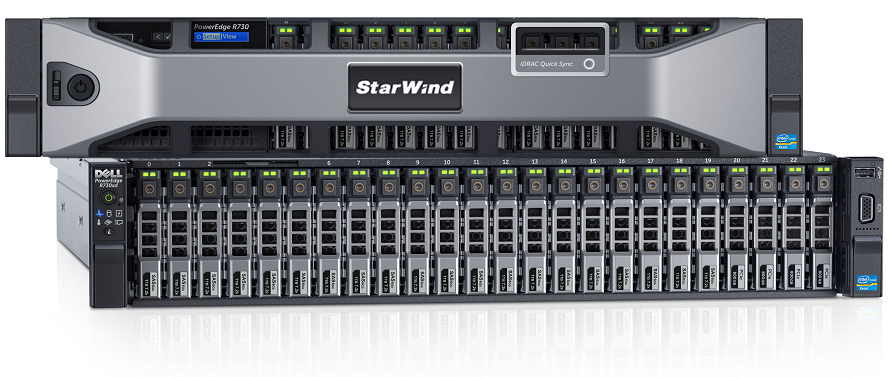Introduction
Today storage is no longer the superhot area of interest of venture capitalist (VC) investments that it once was. It is still of significant importance, however. Storage is always evolving, and innovative trends have been establishing themselves and became commodities. Even while storage is no longer the poster child example for technology startups and hot technology for venture capitalists to invest in, it remains a fascinating subject. Maybe it is a good thing for the storage market that the volatility has subsided, and we can focus on the delivered value. That focus on value is what characterizes the current storage companies.
Figure 1: Bring your own storage is how Veeam offers flexibility and value at excellent price points (Photo by Manuel Geissinger from Pexels)
What has become very hot over the last two years is the backup market. It has exploded. That happened due to the fact there is a huge market and as such plenty of opportunities. Partially this is because the needs are evolving with ever more hybrid and cloud storage options around. New storage options, in this case, also mean more locations to store data. In these locations, we can keep the primary data we want to protect or the backups themselves. Like with storage before, we see a boom in new backup companies trying to become the next big thing or at least hope that someone will buy them when promising enough. The fact that all that venture capitalist money has to go somewhere also fuels this.
Backup solutions require storage
I am pretty sure that in several years the backup market will settle down. We’ll see consolidation take place. Many startups and smaller players will either be bought by larger entities or disappear. The better ones can and will evolve into viable competitors to the currently established players. In a crowded market, this inevitably leads to wrong bets in technology offerings as not all of them can be the best. Or as a man, who is way smarter than me, once told me, “the sucker spot is never empty.” Fascinating as all this might be, we are not going to discuss that any further here.
When we talk about backup, we inevitably talk about storage. No matter what size, shape, or form it comes in, storage is what you need to store the backups. In regards to storage solutions, I always like to prevent vendor lock-in. I also strive to maintain the flexibility to use or recuperate any storage that is at hand. That way, I can leverage it to cater to our backup needs. That’s why I prefer to stay away from backup vendors that force hardware on me. I can live with solution providers who develop some best practice-based storage solutions we can buy with the hardware as part of a service, but I do not like vendors who do not give me a choice.
Figure 2: More and more data centers and server rooms color Veeam green and with good reason (Photo by Manuel Geissinger from Pexels)
For backup solutions, I like to stay as independent of hardware and storage solutions as possible. That has always been the case. Why? I have found this offers me the most value and flexibility at the best price point based on the needs at hand in any design. It will not surprise anyone that Veeam fits the bill perfectly. It allows me to leverage any hardware and storage that I can get possibly get my hands on. That means that the responsibility of ensuring that the backup storage is of sufficient quality and can deliver the capacity and performance required lies with me. I can do that myself or hire that expertise. That equally holds for small, medium, and large enterprises, all the way to the top of the Fortune 500. No matter what storage choices I make, as long as they are sound, Veeam delivers the features and flexibility to build world-class backup solutions with a wide variety of storage options. Remember that a complete solution can use different storage types for different needs.
My doctrine for backup storage is to focus on current needs with an eye on the future. That means I also maintain a short-term to a medium-term roadmap to make sure I can keep my backup storage up to date and provide enough capacity and performance in an economically feasible manner. That means I know what storage can be leveraged for backups when it becomes available, and I can integrate it into the solutions I build. It can be new hardware, but I often have primary storage being replaced and put into service in backup roles. So what are the technologies that are capturing my and many of you their attention right now?
Storage capabilities and trends
When we look at exciting and available storage technologies and features, the following items come to mind.
- Object-based storage, with or without immutability, and both in the cloud and on on-premises
- ReFS and XFS offer fast cloning, capacity optimization, file integrity monitoring, file system repair, or even data repair.
- Next to DAS, SAN, NAS/file shares, we also find software-defined storage solutions such as Storage Spaces. It offers the ability to leverage high-performance NVMe and capacity drives (SSD/HDD) in single storage solutions, transparent for the process using it.
Veeam offers a tremendous amount of flexibility to leverage a broad and diverse range of storage offerings. You can use them to build scalable and performant backup solutions that will meet your needs and budget. From single-server systems to large scale-out repositories that can even be highly available if so desired, Veeam can handle it. You can design and build your solution with the storage of your choice to create a complete and flexible backup solution.
Microsoft’s position in backup storage
Microsoft has an attractive but also somewhat confusing position when it comes to backup storage over the past six years or so. They have managed to deliver a tremendous amount of flexibility and features that come natively in Windows server in the form of Storge Spaces and ReFS. It has made Windows Server much more than just an operating system to host NTFS LUNs for either direct-attached storage or file shares as backup targets.
So you would think this means they are in the right place, maybe even a desirable place to build on. With ReFS, Microsoft has undoubtedly captured the interest of many in the backup market. Combined with Storage Spaces and the various options for building a software-defined storage solution to fit your needs, ReFS shines even more.
That interest was seemed almost unexpected and despite their lackluster enthusiasm to optimize, evangelize, and support these technologies for backup storage uses cases. I recall when ReFS finally got official support for archival workloads on anything but storage spaces and simple local volumes. They added quality certified SAN and RAID controllers on the HCL as longs it was not running on clustered shared volumes. I had been a long time advocate for those use cases.
Next to that, they struggled with the stability and performance of ReFS in Windows Server 2019. That took way too long to resolve. It caused a loss of trust in ReFS meaning people started to look for alternatives. Hence today, we are in a state where Linux XFS is in the spotlight and has caught the attention of people designing and building backup solutions. The success stories of XFS are eating away at the backup market potential of ReFS, Windows, and partially of Storage Spaces.
Another undeniable and unstoppable fact is the rise of object-based storage. Object-based storage arrived early on the backup world scene but is now growing faster than ever before. All this while Microsoft, except in the public cloud or maybe some decentralized Azure offerings, seems to have no interest in object-based storage in hybrid or on-premises scenarios for backup use cases.
With object-based storage, both on-premises and even in the cloud, we miss the immutability feature that AWS S3 compatible storage offers at the bucket level (object-lock, compliance mode). Microsoft misses out on a vital component for 3rd party backup vendors in today’s ransomware threat landscape, even in the cloud. To me, that means they are losing Azure consumption opportunities.
There seems little to no optimization or focus to enhance Storage Spaces solutions and ReFS for backup scenarios. The results are non-optimized SKU offerings and little enthusiasm by Microsoft for backup use cases, it seems. All this despite a large number of successful implementations by many fellow MVPs and other community leaders. It leads to doubt and confusion with customers, costly licensing options, makes service providers look to other options, and make consultants consider alternatives.
My take on it all
Today the lure of XFS on Linux is enormous. The success of XFS in reliability and scalability are too good to ignore. That happened while Microsoft took a long time to address stability and performance issues with ReFS in Windows Server 2019, and while some enhancements are only available in newer SAC releases.
Now also consider the following. We see the massive rise of object-based storage for data protection and the introduction of Linux-based immutable backup storage. Combine these two, and it is crystal clear that this is where the backup market is heading. You can witness this yourself today. There is no need to be a visionary o do this. Look at what happing at Veeam, for example.
In a Veeam Backup & Replication V11 repository, the immutability feature leverages a Linux filesystem native feature. In Linux, a file can have the “i” attribute set. When set, a file cannot be changed or removed.
Figure 3: Veeam Backup & Replication V11 delivers immutability with Linux & bring your own storage! (image by Veeam)
When Veeam creates backup files, it sets the “i” attribute. After the configured period of immutability has passed, a dedicated local Veeam service (daemon) removes the “i” attribute, allowing deletion of the file (chain). While the Veeam service veeamimmureposvc has root access to set the “i” attribute, it has no network access and cannot be compromised remotely. Try doing that with Windows! It just isn’t there. Can this be done with Windows? Maybe, but it will be hard. The “read-only” attribute won’t hack it to achieve the same, I am afraid. And securing the Windows box is not an easy feat. My guess is they looked at doing so. The fact that we have a Linux solution might indicate that this the more achievable result. There is a lot more to discuss, such as removing ssh, certificate-based authentication, adding MFA, leveraging SELinux, etc. But I leave all that for another opportunity.
On the other hand, there are companies out there like Starwind that build “turn-key” backup storage solutions that do not tie you into a backup vendor.
Figure 4: Dedicated & optimized Starwind backup appliance (image by Starwind)
Their appliances come optimized in every way possible, feature-rich, and attractively licensed. These can be used perfectly fine with Veeam and allow for scale-out and scale-up. Again, it gives me flexibility without vendor lock-in.
Backblaze is offering affordable AWS S3 compatible cloud storage, which integrates with Veeam’s immutability capabilities. MinIO provides the possibility to build AWS S3 compatible storage for the same use case on-premises while bringing our own storage.
Next to the ones mentioned here are many other storage players offering solutions that specifically target the backup market but leave you the freedom of designing the best backup solution with Veeam.
What does this all mean? Either Microsoft has no interest in this market segment, or it just mismanaged the advantages they had with ReFS. I think it is the former. Microsoft is smart enough and has the resources needed to make a massive impact in this market segment. But, when looking at their actions as they don’t tell me, I conclude that Microsoft is happy to leave this market segment to others. They do not fix technical issues (ReFS) fast enough, and they don’t create SKUs that optimize licensing of features for backup use cases. I also don’t see them entering the object storage market outside of Azure offerings. Azure consumption is and will be their primary focus for quite a while. They build technologies to support that focus. While the technology they make might trickle down to Windows Server for on-prem or hybrid deployments, that does not seem to happen for backup use cases. But even in Azure, we still have not seen any progress in supporting the immutability feature of Veeam for its capacity tier in Scale-Out Backup Repositories. In contrast, in the AWS S3 compatible world, this has been steadily increasing in both on-prem and cloud offerings. Ransomware drives the customer need for this, meaning the market opportunity is there.
As someone who has evangelized (and still does) the benefits of ReFS and Windows backup targets, I think this is a lost opportunity for Microsoft. But that is my personal opinion. In the grand scheme of things (and revenue), my opinion does not matter. So yes, I will be paying more attention to other technologies and operating systems in the future. Don’t get me wrong; in the Microsoft ecosystem, we had a good run with the current opportunities. And it still offers a lot of great features and capabilities I leverage today. But the evolution needed to make it even better is out of my control, and I don’t see it happening outside of Azure.
So I plan to embrace these other, to me new, technologies. Sure, I know about them, but I do not have any or sufficient hands-on experience yet with some of them. That does not mean that Windows Server-based solutions with or without ReFS are off the table now. It does mean the spread has become a lot larger and more affluent. As a technologist, that makes for exciting opportunities to deliver more value. Veeam is leading the way here by allowing us to make the most of all those options. That enables us to optimize our solutions tailored to the needs and possibilities at hand while still enjoying those “it just works” capabilities of Veeam. I’m pretty confident they will keep on doing that in the future.






